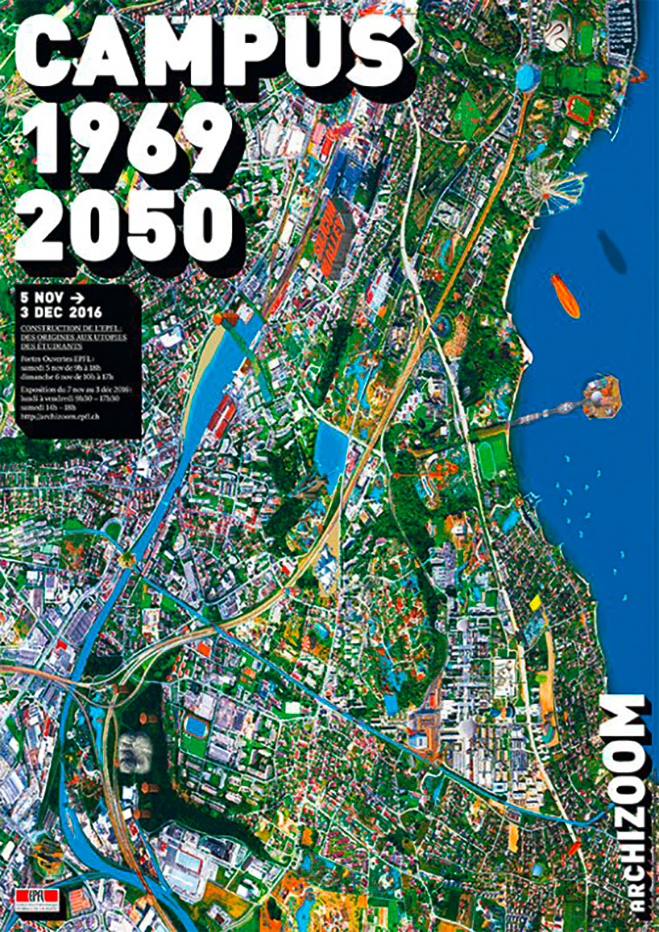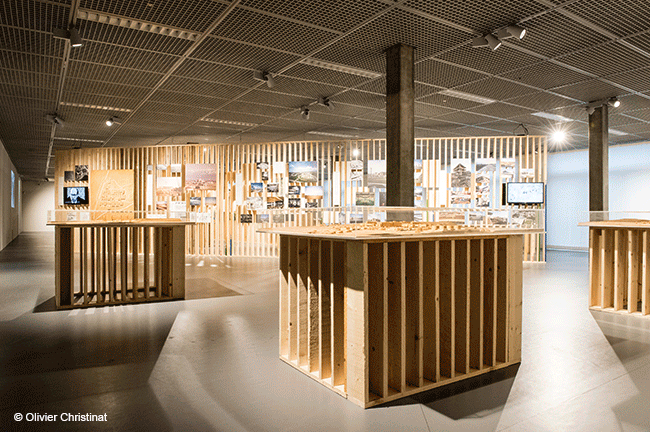Chronicle of EPFL’s architectural life from origins to utopia

November 5 – December 3, 2016
EVENTS
Open Days EPFL
Saturday 5 November 9:00-18:00
Sunday 6 November 10:00-17:00
Les jardins secrets de l’EPFL
Parcours-Découverte
Guided tour of the exhibition and of the campus.
In less than 50 years rape fields to the west of Lausanne have morphed into a small city of over 14,000 people, that radiates throughout the region and the world. Created in 1969, the École polytechnique fédérale de Lausanne opened its new campus in the city outskirts in 1978. It was built to respond to the needs of a rapidly evolving community constantly ahead of its time. With a high urban density the EPFL site is seen as a laboratory for the planning processes and architectural directions that influence a society’s work and moves.
The first stage of this large building project was based on a very efficient, uniform and modular principle of construction but this modernist systematic approach generated problems of orientation that led to the revision of the orthogonal master plan. In the 1980s diagonal circulation was introduced and new architects were appointed for the design. A third stage in the 1990s connected the EPFL to the new train line. Since 2000 the campus activities have intensely diversified: new spaces for businesses, library, students housing, hotel, congresses, cultural events, and soon the national media with the RTS new headquarter; meanwhile teaching went online with the MOOCs.
This exhibition aims to show the crucial importance of the architecture program in the organisation of the campus. The architects anticipate the hardships of tomorrow. They work on existing models, on immediate needs and on anticipating practises; three different temporalities that produce a subtle craft relying on economic conditions. Each initiative is part of a continuum and creates new modes of social organisation and land use. The exhibition includes audio recordings of architects interviewed in situ, which completes the presentation of the site with the voices of those who built it.
But history does not stop there. The exhibition outlines the new challenges that a European university must take up today. During their last year of training the students in architecture have focused on imagining projects centred on the theme of education and campus, as the ones who have a stake in the constant transformation of a remote site which they have looked at from up close and which is becoming one of the main poles of interest to the west of Lausanne, being today much more than a place of study. The students’ works mix prospective, critical and utopian approaches in a wholly original way. The campus brings together disciplines, links up with the city, rethinks its rapport with the larger landscape and inscribes itself in urban emerging discourses.
An exhibition produced by Archizoom in collaboration with :
Alice Chénais, curatrice
Nancy Couling, recherche partie historique
Alice Chénais et Victoire Paternault, scénographie
Montage :
Quentin Vandenhaute, Barbara Woloszczyk, Erminia Mossi, Mathilde Loiseau, Charlotte Roche-Meredith, Rafael Durussel, Sébastien Chevallaz
Prêt des œuvres :
Acm, Archives de la Construction Moderne EPFL
DII, Domaine Immobilier et Infrastucture EPFL
SUPERSTUDIO, laba & ALICE, ateliers d’architecture
Remerciements :
Atelier des maquettes de l’EPFL
Antoine Gagliardi, Laurent Emmenegger
Archives de la construction moderne (Acm)
Salvatore Aprea, Joëlle Neuenschwander
Médiacom
Sandy Evangelista, Marie-Noëlle Perseguers, Magaly Mathys
Service audiovisuel de l’EPFL
Marc Delachaux, Olivier Porchet
Scan des images
Nuno Miguel Da Costa Martins
IT3 Service informatique
Nicolas Chevalley, Loïc Nguyen
Domaine immobilier et infrastructure de l’EPFL (DII)
Pierre Gerster, Florent Déseneux
Campus Durable
Philippe Vollichard
ainsi que
Lawrence Breitling, Catherine Seiler, Marie Sagnières
Loans :
Acm, Archives de la Construction Moderne EPFL
DII, Domaine Immobilier et Infrastucture EPFL
SUPERSTUDIO, laba & ALICE, ateliers d’architecture
Exhibition views
